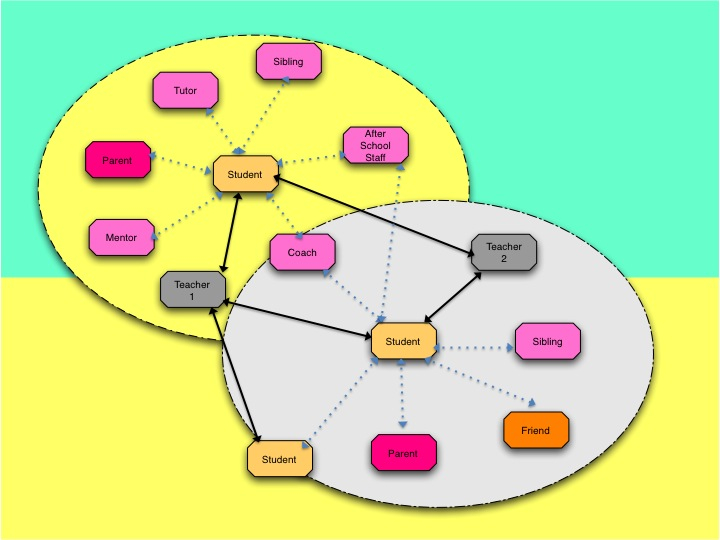Summary: Texting for Rapid Youth Support
From Oneville Wiki
Written by Mica Pollock, Uche Amaechi, Maureen Robichaux, and Ted O'Brien for the texting project, with input from students piloting texting at Full Circle/Next Wave
Click here for the Overview and key findings on this project; click here for the Expanded story on this project.
What communication challenges did this project address?
There is often a gap in rapid support communications with young people in schools. People don’t always have time to meet face to face to discuss students’ needs and experiences. Many students at risk of dropping out are absent from school quite a lot. Often, teachers don’t know how youth are doing outside of school and other supporters are unaware of how youth are doing in school. All this in an era when technology could make rapid communication with young people more normal than ever in schools!
Over the 2010-11 school year, we worked with two teachers and 40 young people at Somerville’s alternative middle and high school to test texting as a tool for rapid youth support. All 40 students have chosen or been forced to leave Somerville’s mainstream schools and are vulnerable to dropout. They’re also fabulous young people, and great research partners.
Our initial vision was to enable an entire support “team” to communicate rapidly, using whatever media would work best. We ended up finding student-teacher texting (primarily over sms, but also using various internet based services) so fruitful that we stayed with it for the entire 2010-11 year. We’ll continue to test one-to-one texting between four new teachers and their students in 2011-12, allowing us to see what happens when people new to texting get rolling. We’ll also now test a group texting tool supporting rapid communication between “teams” of youths’ chosen supporters. We’ll also test a tool allowing teachers to “blast” texts to all of their students at once.
Why is it important to improve communications?
What we found:
- ¡Aha! Texting can provide anytime, anywhere, rapid youth support and also glue together student-teacher relationships re. academics and school. The practical benefits of being able to reach people for check-ins and questions go hand in hand with the ability to build relationships outside the school day.
- ¡Aha! Texting is a “common-denominator” tool that allows more students to communicate with teachers. People can use regular phones, smart phones, and computers to communicate via text message.
- ¡Aha! Texting also supports personalized, two-way communication between youth and their supporters, about a range of school-related and life topics.
- Main ¡Aha! To students, texts demonstrated caring because they demonstrated effort by both students and teachers to respond to the other. And as texting partners actively "cared" about the person on the other end of the line, texts could also make people care more about student success. As students and teachers both noted, texting allowed students and teachers to support each other as well as "bond," in ways crucial for solidifying students' commitment to both teachers and school.
- ¡Aha!All texts sent between school personnel and students are school "records," meaning they can be reviewed for safety and accountability as needed. At the same time, we're seeing that the feeling of quiet privacy that texting affords can jumpstart personalized support for students less likely to articulate their needs publicly in school. We have tried texting between teachers and individual students; we’ll next try using mobile messaging to support communication among a “team” of supporters of students’ choice.
How does texting for rapid youth support work? How would it be implemented?
- Go with those teachers (and students) that are excited. It’s crucial to start with people who really want to communicate in a particular way — who are motivated by the technology or the flexibility. These people are most likely to innovate a new piece of communication infrastructure for their school or district. When others see what is possible, they'll join in.
- Spend enough time learning to use the texting technology. We used Google Voice, which allowed teachers to use their phones or their computers to review and send text messages. The tool also captured texts for safety and accountability.
- Spend enough time discussing potential and actual uses for the texting communication and support. When will teachers be available? For what? How often? Will they focus on specific students or try to connect with all students equally? What supports will the teachers have within the school, especially if students express serious needs? The district?
- Collectively set expectations and ground rules for texting communication -- ideally through a face-to-face meeting with everyone that will be involved, where everybody’s concerns and suggestions are heard. Draw up a contract so everybody is clear on what is appropriate. In our pilot, both students and teachers were impressed with the level of "politeness while texting" that occurred. No one felt that inappropriate texts were sent.
- Connect each teacher with all the students who want to participate in texting. Make sure teachers have up to date contact information for all students. (In our pilot, even while some students lost phones or ran out of minutes, far more were able to participate than if rapid communication had depended on computers or home phones.)
How do you know if your school could improve communication?
Questions to ask about the current system in your school:
- ➢ In your school, when students have personal questions or needs, are there ways for them to privately and/or rapidly reach their supporters?
- ➢ How do teachers supplement their often-limited interactions with students during the school day?
- ➢ How much do teachers communicate with students and families outside of the classroom?
- ➢ What type of relationships and interactions do teachers have with their students, both in and outside of the classroom?
- ➢ What policies, structures, and norms do teachers and students have for interacting outside of class?
- ➢ Could texting help with rapid and/or more personalized/private youth support? What are your reservations about texting, and how might these be addressed?
The Next Layer: Connecting to Folks Doing Similar Work in Other Communities.
We'd love to spark a lively exchange between people working on similar things.
Want to talk further?
Are you working on improving communications in your own school or community?
Contact point people for the texting project directly at:
Uche Amaechi (amaechi@gmail.com); Maureen Robichaux (mrobichaux@k12.somerville.ma.us); Mica Pollock (mica.pollock@gmail.com)
Click here for the Overview and key findings on this project; click here for the Expanded story on this project.

